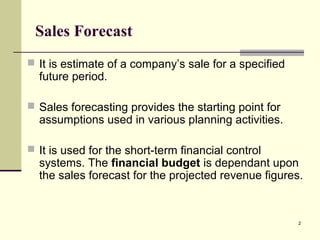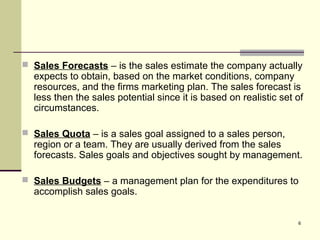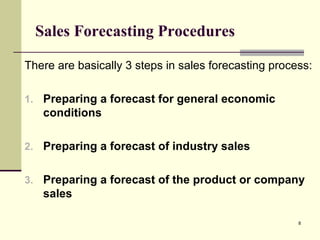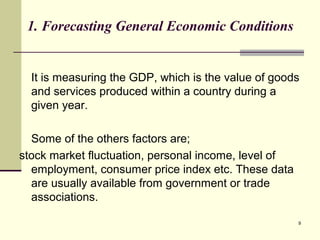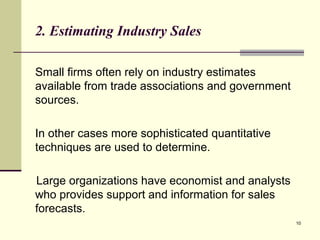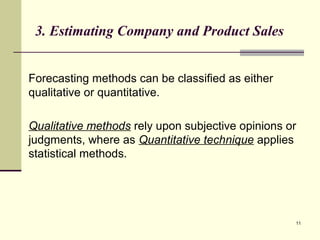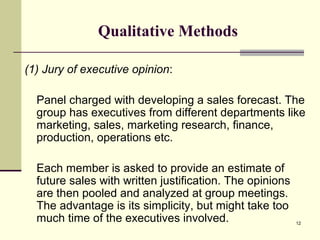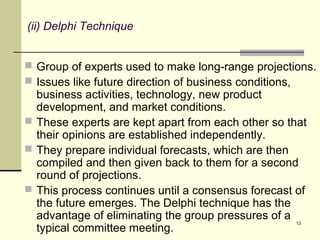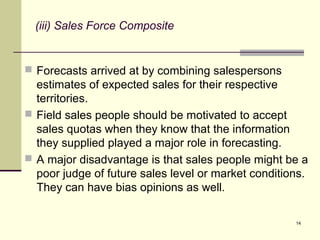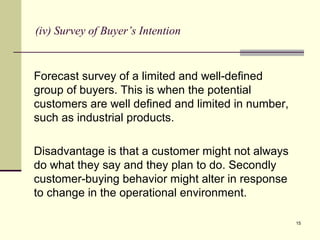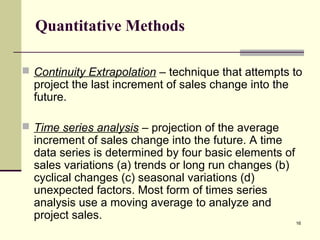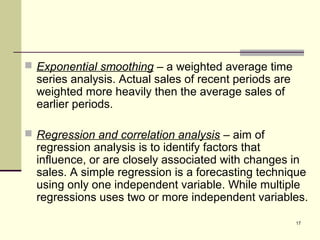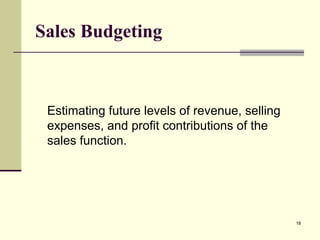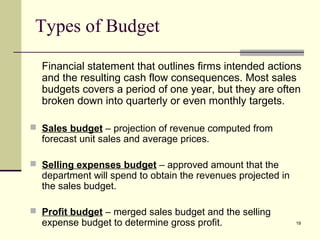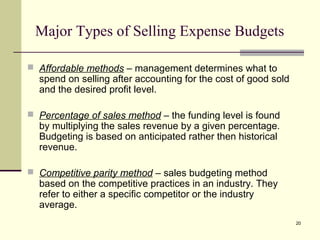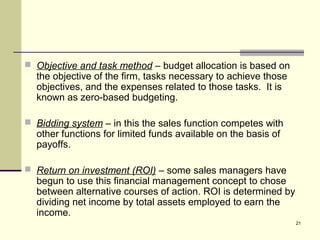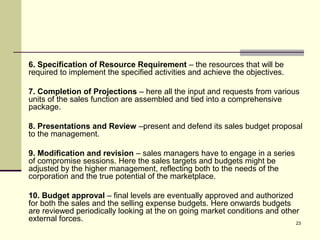Forecasting and budgeting
- 1. 1 Sales Forecasting & Budgeting Prof. N.Gurunatha Naidu SVIM
- 2. 2 Sales Forecast ’ü« It is estimate of a companyŌĆÖs sale for a specified future period. ’ü« Sales forecasting provides the starting point for assumptions used in various planning activities. ’ü« It is used for the short-term financial control systems. The financial budget is dependant upon the sales forecast for the projected revenue figures.
- 3. 3 ’ü« Human resource executives use sales forecasts to project staffing needs, financial executives use it in establishing and controlling operating and capital budgets, and production manager uses it to schedule purchasing and production to control inventories. ’ü« It is thus a very vital planning task for any organization.
- 4. 4 Sales Forecasting Concepts There are 5 levels of concern in sales forecasting: (a) Market Potential (b) Sales Potential (c) Actual Sales Forecasts (d) Sales Quotas (e) Sales Budgets
- 5. 5 ’ü« Market Potential ŌĆō it is the highest possible expected industry sales of a good or service in a specified market segment for a given time period. ’ü« Sales Potential ŌĆō refers to an individual firms market share of the market potential, where market share is defined as the percentage of market controlled by a particular company or product. It is the maximum sales a firm can hope to obtain.
- 6. 6 ’ü« Sales Forecasts ŌĆō is the sales estimate the company actually expects to obtain, based on the market conditions, company resources, and the firms marketing plan. The sales forecast is less then the sales potential since it is based on realistic set of circumstances. ’ü« Sales Quota ŌĆō is a sales goal assigned to a sales person, region or a team. They are usually derived from the sales forecasts. Sales goals and objectives sought by management. ’ü« Sales Budgets ŌĆō a management plan for the expenditures to accomplish sales goals.
- 7. 7 Product Life Cycle Important sales planning and control tool; it projects the changes in a products sale/profits that occurs over time. ’ü« Introduction stage ŌĆōThere is no historical sales record and new products have a high failure rate, so it very important to prepare realistic estimate of potential sales, based on thorough marketing research. ’ü« Growth stage ŌĆō if the product gains market acceptance. Sophisticated mathematical models are used here to project market share and estimate sales. ’ü« Maturity and Decline stage ŌĆō traditional forecasting techniques are appropriate. Historical data can be analyzed statistically to project sales.
- 8. 8 Sales Forecasting Procedures There are basically 3 steps in sales forecasting process: 1. Preparing a forecast for general economic conditions 2. Preparing a forecast of industry sales 3. Preparing a forecast of the product or company sales
- 9. 9 1. Forecasting General Economic Conditions It is measuring the GDP, which is the value of goods and services produced within a country during a given year. Some of the others factors are; stock market fluctuation, personal income, level of employment, consumer price index etc. These data are usually available from government or trade associations.
- 10. 10 2. Estimating Industry Sales Small firms often rely on industry estimates available from trade associations and government sources. In other cases more sophisticated quantitative techniques are used to determine. Large organizations have economist and analysts who provides support and information for sales forecasts.
- 11. 11 3. Estimating Company and Product Sales Forecasting methods can be classified as either qualitative or quantitative. Qualitative methods rely upon subjective opinions or judgments, where as Quantitative technique applies statistical methods.
- 12. 12 Qualitative Methods (1) Jury of executive opinion: Panel charged with developing a sales forecast. The group has executives from different departments like marketing, sales, marketing research, finance, production, operations etc. Each member is asked to provide an estimate of future sales with written justification. The opinions are then pooled and analyzed at group meetings. The advantage is its simplicity, but might take too much time of the executives involved.
- 13. 13 (ii) Delphi Technique ’ü« Group of experts used to make long-range projections. ’ü« Issues like future direction of business conditions, business activities, technology, new product development, and market conditions. ’ü« These experts are kept apart from each other so that their opinions are established independently. ’ü« They prepare individual forecasts, which are then compiled and then given back to them for a second round of projections. ’ü« This process continues until a consensus forecast of the future emerges. The Delphi technique has the advantage of eliminating the group pressures of a typical committee meeting.
- 14. 14 (iii) Sales Force Composite ’ü« Forecasts arrived at by combining salespersons estimates of expected sales for their respective territories. ’ü« Field sales people should be motivated to accept sales quotas when they know that the information they supplied played a major role in forecasting. ’ü« A major disadvantage is that sales people might be a poor judge of future sales level or market conditions. They can have bias opinions as well.
- 15. 15 (iv) Survey of BuyerŌĆÖs Intention Forecast survey of a limited and well-defined group of buyers. This is when the potential customers are well defined and limited in number, such as industrial products. Disadvantage is that a customer might not always do what they say and they plan to do. Secondly customer-buying behavior might alter in response to change in the operational environment.
- 16. 16 Quantitative Methods ’ü« Continuity Extrapolation ŌĆō technique that attempts to project the last increment of sales change into the future. ’ü« Time series analysis ŌĆō projection of the average increment of sales change into the future. A time data series is determined by four basic elements of sales variations (a) trends or long run changes (b) cyclical changes (c) seasonal variations (d) unexpected factors. Most form of times series analysis use a moving average to analyze and project sales.
- 17. 17 ’ü« Exponential smoothing ŌĆō a weighted average time series analysis. Actual sales of recent periods are weighted more heavily then the average sales of earlier periods. ’ü« Regression and correlation analysis ŌĆō aim of regression analysis is to identify factors that influence, or are closely associated with changes in sales. A simple regression is a forecasting technique using only one independent variable. While multiple regressions uses two or more independent variables.
- 18. 18 Sales Budgeting Estimating future levels of revenue, selling expenses, and profit contributions of the sales function.
- 19. 19 Types of Budget Financial statement that outlines firms intended actions and the resulting cash flow consequences. Most sales budgets covers a period of one year, but they are often broken down into quarterly or even monthly targets. ’ü« Sales budget ŌĆō projection of revenue computed from forecast unit sales and average prices. ’ü« Selling expenses budget ŌĆō approved amount that the department will spend to obtain the revenues projected in the sales budget. ’ü« Profit budget ŌĆō merged sales budget and the selling expense budget to determine gross profit.
- 20. 20 Major Types of Selling Expense Budgets ’ü« Affordable methods ŌĆō management determines what to spend on selling after accounting for the cost of good sold and the desired profit level. ’ü« Percentage of sales method ŌĆō the funding level is found by multiplying the sales revenue by a given percentage. Budgeting is based on anticipated rather then historical revenue. ’ü« Competitive parity method ŌĆō sales budgeting method based on the competitive practices in an industry. They refer to either a specific competitor or the industry average.
- 21. 21 ’ü« Objective and task method ŌĆō budget allocation is based on the objective of the firm, tasks necessary to achieve those objectives, and the expenses related to those tasks. It is known as zero-based budgeting. ’ü« Bidding system ŌĆō in this the sales function competes with other functions for limited funds available on the basis of payoffs. ’ü« Return on investment (ROI) ŌĆō some sales managers have begun to use this financial management concept to chose between alternative courses of action. ROI is determined by dividing net income by total assets employed to earn the income.
- 22. 22 Sales Budgeting Procedures 1. Situational Analysis ŌĆō sales managers have to look at the magnitude of past differences between budgeted and actual figures and the reasons for these differences. 2. Identification of Problems and Opportunities the actual potential threat and challenges has to be assessed and addressed to determine the probabilities of occurrence their impact. 3. Development of Sales Forecast ŌĆō manager is equipped to forecast sales, using one of the various methods. Projections are made about the anticipated levels of sales by territory, product or type of account. It is expressed both in units and dollars. 4. Formulation of Sales Objectives ŌĆō once the forecast has been developed, sales force has to be told what sales target to strive and what objectives to pursue. 5. Determination of Sales Tasks ŌĆō sales manager and sales force have to carry a broad array of sales activities, ranging from recruitment to evaluation, and from prospecting to after sales service.
- 23. 23 6. Specification of Resource Requirement ŌĆō the resources that will be required to implement the specified activities and achieve the objectives. 7. Completion of Projections ŌĆō here all the input and requests from various units of the sales function are assembled and tied into a comprehensive package. 8. Presentations and Review ŌĆōpresent and defend its sales budget proposal to the management. 9. Modification and revision ŌĆō sales managers have to engage in a series of compromise sessions. Here the sales targets and budgets might be adjusted by the higher management, reflecting both to the needs of the corporation and the true potential of the marketplace. 10. Budget approval ŌĆō final levels are eventually approved and authorized for both the sales and the selling expense budgets. Here onwards budgets are reviewed periodically looking at the on going market conditions and other external forces.
- 24. THANK YOU 24


